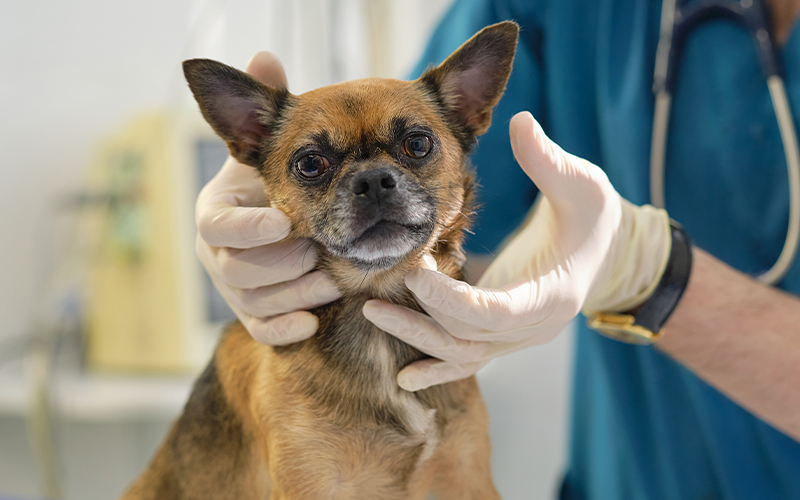Tracheal Collapse in Dogs

What is tracheal collapse?
Tracheal collapse occurs when the inside diameter of a dog’s trachea (windpipe) is decreased. This narrowing decreases the amount of air that can enter the airways and lungs.
Tracheal collapse can occur one of two ways:
- Traditional-type, which results from decreased stiffness in the tracheal cartilage, which weakens the tracheal tissue
- Malformation-type, where the inside of the trachea has an abnormal shape
This disease tends to affect middle aged to older toy and small breed dogs, with the Yorkshire Terrier being the most commonly affected breed.
What are the signs of tracheal collapse?
The most common sign of tracheal collapse in dogs is coughing (which often sounds like a goose honking), especially when dogs get excited or pull on their leash. Other signs include wheezing and rattling in the throat or neck area.
Dogs can also develop a life-threatening form of this condition, with a rapid breathing rate, difficulty breathing, collapse, and/or blue discoloration to the gums and tongue. The normal breathing rate for dogs is less than 30-40 breaths per minute. If you detect an elevated respiratory rate, or notice difficulty breathing, collapse, or blue discoloration, your dog should be seen immediately by a veterinarian.
What tests are required?
Your veterinarian will begin with a physical examination of your dog. A useful test is to gently touch the neck - most dogs with collapsing trachea will cough when the trachea is gently pressed. Your veterinarian will also listen to your dog’s heart and lungs, since some dogs with this condition can develop abnormal sounds in the lungs and a heart murmur (secondary to increased pressure in the lungs).
The most useful test to diagnose collapsing trachea is an x-ray of the chest and neck. The x-ray may show a narrowed or undulating trachea, which is diagnostic for this disease. However, x-rays only show a snapshot in time; therefore, they may be normal even in a dog with significant tracheal collapse. In these cases, a veterinary specialist may perform fluoroscopy (live x-rays) or tracheobronchoscopy (camera inserted into the trachea and lower airways).
Your dog may need sedation to safely perform an x-ray. If your dog is severely affected with collapsing trachea and requires oxygen therapy, your veterinarian may not be able to safely perform an x-ray until your dog is stable.
What are treatment options?
Treatment options depend on the severity of your dog’s clinical signs. If your dog is stable or has mild clinical signs, your veterinarian may start with one medication and only add other medications if signs progress.
Cough suppressants are the first line treatment. This is because coughing causes inflammation in the airway, which then causes more coughing. Cough suppressants help break this cycle. If your dog coughs with excitement, an anti-anxiety medication may also be helpful.
If your dog has a respiratory crisis, then oxygen therapy will be required. Sedation is helpful to decrease coughing and anxiety. If your veterinarian suspects a lot of inflammation, steroids may also be needed to decrease swelling in the airway. These dogs often lack the normal protective mechanisms against airway infection and are therefore predisposed to airway infections. For these dogs, antibiotics are necessary.
Tracheal collapse can be exacerbated by environmental allergens, warm weather, obesity, and neck leads/leashed. Therefore, lifestyle changes can help decrease signs:
- Remove any allergens or irritations that cause coughing, such as cigarette smoke
- Use a body harness instead of a neck collar
- Maintain an ideal body weight
- Keep your dog in a cool environment, especially on a hot or humid day
- Decrease your dog’s exposure to stressful or exciting events which can trigger coughing
If your dog has severe clinical signs despite medications, or if your dog is experiencing a respiratory crisis, a tracheal stent placed by a veterinary specialist may be necessary. This is a tube that is placed within the trachea that helps hold it open so it doesn’t collapse. However, due to the potential for complications, such as infection, stent fracture, migration, and granulation tissue, these are typically reserved only for dogs that fail medical management or are experiencing a respiratory crisis.
What is the outcome after treatment?
Patients with minimal tracheal collapse without other complicating factors can do well with lifestyle changes and appropriate medical management.
Tracheal collapse tends to be progressive, with signs getting worse as a patient gets older. As the disease progresses, additional interventions may be required, and it can be hard to control this disease. For these patients, the priority is to decrease symptoms and maintain a comfortable quality of life, since cure is not possible.
Articles by Specialty
- Cardiology (19)
- Large Animal Internal Medicine (23)
- Neurology (17)
- Oncology (21)
- Small Animal Internal Medicine (29)
Articles by Animal
- Cats (35)
- Dogs (52)
- Farm Animals (5)
- Horses (12)
